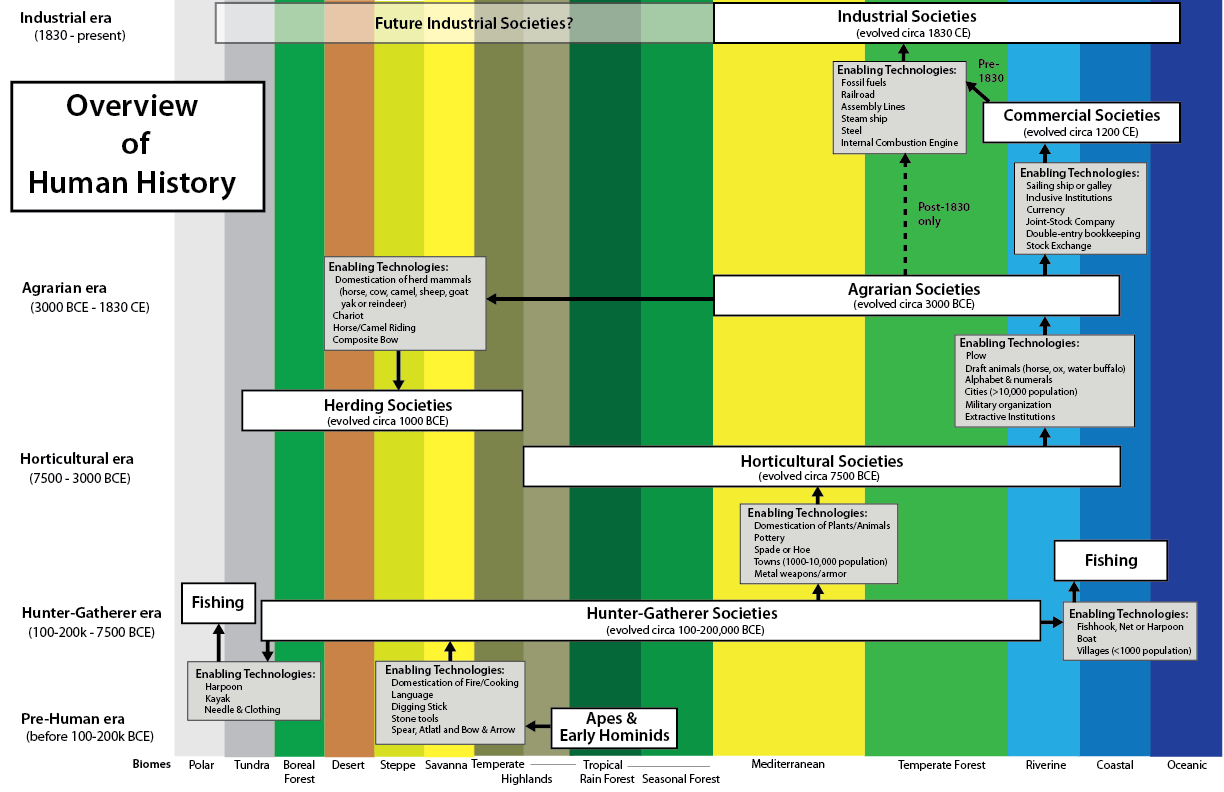Make someone’s day: Gift a subscription to your friends and family!
I love history. Political history, economic history, military history, and the history of science and technology. You name it. I love it all.
Unfortunately, most people do not. Recently I read that the History major is one of the fastest-declining college degrees in terms of the number of graduates. As a former history major, this saddens me.
I think a big part of the reason is how history is taught in school. It is typically taught as an onslaught of names, dates, and events. I think that most students never get the big picture explained to them in a way that fits all the names, dates, and events into one narrative. I believe that there is a narrative embedded in the concept of progress.
By that, I do not mean that I subscribe to a Whiggish history where all human events show an unfolding progress towards modern civilization and prosperity. Far from it. For most of human history, humans were trapped in poverty by geographical limits on the ability to produce enough food to survive and produce.
There is, however, a narrative that shows humanity’s struggle to overcome that vital geographical constraint. That struggle to innovate new technologies, learn new skills associated with those skills, cooperate together in social organizations to achieve common goals, and compete against other organizations for scarce resources accidentally resulted in human material progress.
Not immediately. It actually took millennia. But it happened nonetheless. And we are the beneficiaries of that struggle. So let’s take a moment to thank our ancestors. And let’s take another ten minutes or so to see how they accomplished it.
So here is my attempt to explain all of human history in one graphic.
Most of the following is an excerpt from my book From Poverty to Progress: Understanding Humanity’s Greatest Achievement. It is part of a series of excerpts that I am publishing on Substack. You can purchase discounted copies of my book at my website, or pay full prize at Amazon.
See also other posts on related topics:
Why are there such huge variations in income across the globe?
All of human history in one graphic (this article)
Commercial societies (which invented modern progress)
The graphic combines together three critical concepts to understand how humans created progress out of poverty:
Society Type (essentially how a society acquires enough food to eat; see a previous post explaining this concept).
Biome (essentially the dominant vegetation in any one geographical area; see a previous post explaining this concept).
Enabling Technologies (key technologies that enable societies to transition from one Society Type to another; these technologies typically are related to food and energy).
Across the bottom of the graphic (x-axis) are biomes, each with color running vertically. I will explain biomes in more detail in later posts, but for now, it is enough to think of them as the dominant vegetation in any one geographical area.
On the vertical axis (y-axis) is the period with the most recent at the top and ancient history at the bottom. By starting at the bottom of the graphic in the “Apes & Early Hominids” box and then working our way upward following the black arrows, we can get a high-level overview of human history.
Each society type is displayed as a white horizontal block demarking which biomes that it can evolve within. In addition, the diagram includes a short list of key enabling technologies (in boxes with a light gray background) that enable societies to transition from one society type to a more complex society type. The thick black lines connecting the enabling technologies with the society types also show in which biomes the first transition occurred in history.
This graphic is packed with useful information. Take a few minutes to take it all in. It will also help you understand future posts on Societies Types.
From this graphic, you can see:
When historians believe a Society Type originated (in white boxes).
Eras when a specific Society Type was dominant (left-hand column).
Which biome a Society Type originated within (the color of the vertical column where an upward arrow is located).
Key enabling technologies that enabled societies to “jump” to the next Society Type (in gray boxes).
Which biomes a Society Type was able to migrate to and establish new societies. This often resulted in military conflict and conquest (the color of vertical columns that are covered by the white boxes).
By analyzing this graphic, we can also make a few observations:
Society Types help us to understand human history at a much deeper level.
The following have played a powerful role in human history.:
Humans have invented only a handful of society types. There are only so many ways for large groups of people to produce enough food to survive and reproduce in a specific natural environment. This limits the number of society types that can exist.
Each society type can only inhabit a portion of all the biomes on Earth (although Hunter-Gatherer societies come close to being universal). The vegetation that grows naturally in a biome makes many society types difficult or impossible to evolve because the necessary plants and animals do not exist in that biome.
Some Society types were highly restricted to certain biomes (Fishing, Commercial, Herding, and Agrarian), while others were much more widespread (Hunter-Gather and Horticultural).
Even if society types are somehow able to evolve in the “wrong” biome, those societies will compete with other societies that focus their food production efforts on more cost-effective food sources. This will most probably cause their ultimate failure to survive.The invention of key technologies enabled societies to transition from one society type to another. These technologies were not invented at the same time so the transition was not instantaneous. Compared with how long the previous society type lasted, however, the transition was rapid. This transition is akin to the rapid phase transition that occurs when water has been slowly heated and then suddenly turns into steam.
The transition between society types can only occur in specific “gateway biomes” – biomes that can support both the pre-transition type and the post-transition type.
Societies that evolved in other biomes are effectively trapped in their society type. The biomes that can support the most technologically complex type in any one era differ, so many societies reach evolutionary dead ends.
We will explore this concept in more detail later.
Stay tuned for more on this topic…
Most of the above is an excerpt from my book From Poverty to Progress: Understanding Humanity’s Greatest Achievement. It is part of a series of excerpts that I am publishing on Substack. You can purchase discounted copies of my book at my website, or pay full prize at Amazon.
See also other posts on related topics:
Why are there such huge variations in income across the globe?
All of human history in one graphic (this article)
Commercial societies (which invented modern progress)







Superb (the adjective doesn't do it justice) graphic! It's amazing that you were able to distill so much information into one picture.
Fantastic graphic that packs an amazing amount of concepts together and shows their proper interconnections. Thanks for this.